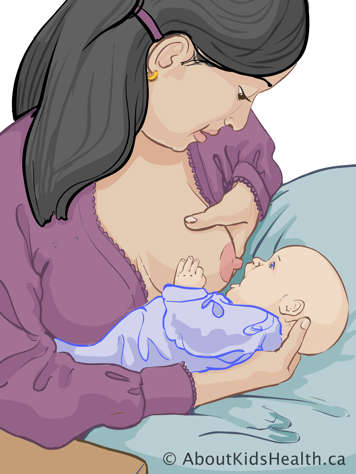The terms 'mother' and 'breastfeeding' are used throughout our documents; we recognize and respect that individuals and families may use other preferred terminology.
Breast milk is the perfect food for most babies. The Canadian Pediatric Society and the World Health Organization strongly support breastfeeding exclusively for the first six months of life. Breastfeeding can then be continued until your baby is two years of age or older, with the addition of complementary solid foods starting at six months of age.
Why is breastfeeding and providing breast milk important for your baby?
Your breast milk has the right nutritional balance for your baby and it changes to meet the needs of your baby as they grow. Some of the benefits of breast milk for your baby include:
- providing antibodies to protect against infection
- providing growth factors for brain, eye and gut development
- reducing the number of illnesses, such as ear, chest and gastric infections
- reducing allergies
- reducing the risk of obesity and becoming overweight
- reducing the risk of certain childhood cancers
- reducing the risk of sudden infant death syndrome (SIDS)
There are also benefits for mothers who breastfeed their babies. Some of these benefits include:
- producing hormones while breastfeeding that help to reduce stress
- building confidence in caring for your baby
- reducing the risk of type 2 diabetes
- reducing the risk of osteoporosis
- reducing the risk of breast and ovarian cancer
- feeding your baby in a way that is free, convenient and environmentally friendly
When should you start feeding your baby?
Start feeding your baby in the first hour after their birth. If your newborn baby is stable, and there are no delivery complications, they should be placed skin-to-skin for up to an hour, until completion of the first feed. Soon after, they may fall into a deep sleep. Typically, after a few hours, they will awaken for their next feed.
How often should you feed your baby?
Your newborn baby will feed an average of eight to 12 times in 24 hours. It is normal for babies to breastfeed every one to three hours, for an average of eight to 12 times in 24 hours. Feeding your baby often stimulates your breasts to produce more milk and helps your baby to grow.
What are feeding cues?
By paying attention to your baby’s behaviour, you will notice cues that will tell you when they are hungry.
Early cues include:
- stirring, rapid eye movements during sleep
- sucking sounds, soft cooing or sighing
- mouth opening
- hand to mouth or sucking/licking movements
- rooting
Late cues include:
- fussiness
- exhaustion leading to sleep
- crying
Whenever your baby shows signs of waking or hunger, you should try to latch them to your breast. This is called feeding on demand. Try to put your baby to the breast when they begin to stir from sleep. It is easier to latch a baby who is calm. If the baby is crying, take time to calm your baby. Babies settle well when placed skin-to-skin. Once calm, try to latch your baby again.
Which breast to feed on
Alternate which breast you start with at each feed. Allow your baby to feed on the first breast for as long as they are sucking and swallowing well. When your baby is no longer swallowing and/or has fallen asleep, stimulate your baby to keep feeding by stroking the baby’s cheek or body, or burping the baby. Then offer the second breast if the baby rouses. Allowing your baby to feed on both breasts will help to establish your milk supply. Once breastfeeding is established, your baby may not always take both breasts at each feed; and the length of time per feed may be shorter.
What is “milk let-down”?
You may notice that your breasts tingle or leak milk when you think about your baby or hear them cry. This is called the milk ejection reflex, or let-down. It is important to remember that not all mothers feel these sensations.
How long can it take to feel confident with breastfeeding?
Both you and your baby are learning this new skill together. It can take four to eight weeks for you to establish breastfeeding. Seek support from a lactation consultant early on if you have difficulties latching or have any questions or concerns.
Breastfeeding positions
Here are a few useful positions you might want to try when breastfeeding: the cross-cradle position, the football position, the cradle position and the side-lying position.
Cross-cradle position

In this position, your baby lies completely on their side, facing you, tummy to tummy. If you are feeding on the left breast, use your right hand to support the baby’s neck and shoulders. This position works well when first learning to breastfeed, or if your baby is small.
Football position

In this position, your baby lies on their back or side and is supported by the hand on the same side as your breast. The breast is held by the opposite hand. The football position works well when you are learning to breastfeed, or if your baby is small. This is also a good position if you have large breasts or if you have had a caesarean birth and cannot place the baby on your abdomen. The football hold is also the easiest way to breastfeed twins at the same time.
Cradle position

In the cradle position, your baby’s head is cradled in your arm on the same side as your breast. Your baby should be turned facing you, tummy to tummy, so that they do not have to turn their head to reach your breast.
Side-lying position

In the side-lying position, you and your baby are lying on your sides facing each other. Your baby’s head should be at your breast level. This is a good position if you find it too painful to sit, have large breasts or if you have had a caesarean section.
There are many different positions. A good position is one that you find comfortable and that allows for a deep latch and easy swallowing.
Latching on
An effective, comfortable latch is very important for successful breastfeeding. This ensures that the baby gets enough milk and that breastfeeding is not painful.
Correct latching

Once you are holding your baby in your preferred position, your baby’s nose should be opposite your nipple. Bring your baby to the breast with their head tilted back, with their chin coming to the breast first.

If your baby is not opening their mouth, lightly stroke your baby's lip with the tip of your nipple. Be patient. Wait for a wide, open mouth (as if your baby is yawning) before bringing them to the breast to latch.

When your baby opens their mouth wide, bring them quickly towards your breast with your nipple pointing up towards the roof of their mouth. Your baby’s head should be slightly tilted back, with their chin pressing into the breast. When latched, your baby’s mouth should remain wide open with lips flanged out.
If you feel pain when your baby latches onto your breast, gently press your baby's chin down with your finger to try to open their mouth wider while they are still latched. If this does not relieve the pain, detach the baby by inserting your finger into the corner of their mouth to break the suction, and attempt to re-latch.
For additional information, please refer to our Position and Latch video on the SickKids website: http://www.sickkids.ca/breastfeeding-program/videos/index.html.
How to know your baby is getting enough milk
Many breastfeeding parents wonder if their baby is getting enough milk, especially in the first few weeks. Your newborn baby is expected to lose some of their birth weight, but they should be back to their birth weight by two weeks of life.
You will know that your baby is getting enough milk if:
- they feed at least eight times in 24 hours
- you see and hear swallows
- by day five, they pass a minimum of three substantial, yellowish bowel movements and soak six or more diapers in a 24-hour period
The frequency of feeding and bowel movements may change as your baby grows.
It is normal for many babies to wake up and show hunger cues very shortly after they have finished breastfeeding. This is often the time when well-meaning relatives suggest a soother or bottle, voicing their concern that you may not have enough milk. When this happens, offer the breast again so they can finish their feed. This infant behaviour is similar to the way that an adult would eat dinner, have a rest, and then be ready to eat dessert.
If you are concerned about your baby’s feeding patterns or your milk supply, please seek help from a lactation consultant.
Growth spurts
You may experience days when your baby wants to eat more often. This typically happens when they are around 3 weeks, 6 weeks, and 10 to 12 weeks old. This change in feeding pattern is related to a growth spurt. This is your baby’s way of telling your body to produce more milk for their growing needs. Your baby will feed frequently for about 48 hours, until your body responds with more milk volume, and then your feeding routine generally returns to normal.
Remember that this is normal feeding behaviour, and there is no need to supplement during this time; your breast milk is enough. If this process is interrupted by supplementing with formula, your milk supply may not increase as needed for your growing baby.
Additional vitamins for baby
Breast milk provides all the vitamins and minerals your baby needs, except for vitamin D. All breastfed babies need an additional supplement of vitamin D. Depending on where you live, your doctor will likely recommend that you give your baby 400 IU or more of vitamin D per day for the first year.
Supplementing with formula
The first few weeks after birth are the most important for establishing your milk supply. Try not to offer your baby any supplemental bottles during this time. If your baby is not gaining weight properly, ask your doctor or lactation consultant for additional help. If you wish to offer a bottle after breastfeeding is well-established, ensure that you pump so that your baby still receives your milk and you are protecting your milk supply. See the article on Expressing breast milk for your hospitalized baby for more information.
Taking medications while breastfeeding
Most medications are safe to take while breastfeeding and are transferred to a baby through breast milk in very small quantities. If you need to take a medication while breastfeeding, check with your doctor, lactation consultant or pharmacist to make sure it is safe. You can also find more information at MotherToBaby.
If you are unable to breastfeed at any time, be sure to pump your breasts as often as your baby feeds to maintain your milk supply.
Are you breastfeeding and returning to work?
If you are returning to work, you can feed your baby on one breast and pump the other breast to deep-freeze your breast milk in the early weeks. This ensures that the alternate caregiver has a continual supply of breast milk to bottle feed your baby when you return to work.

